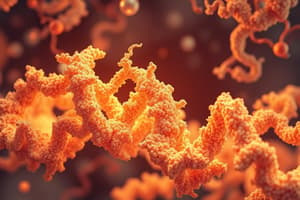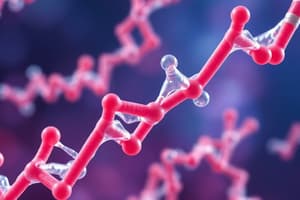Podcast
Questions and Answers
What characterizes the primary structure of a protein?
What characterizes the primary structure of a protein?
- It refers to the folding patterns within the protein.
- It is the sequence of amino acids in a polypeptide chain. (correct)
- It is the unique three-dimensional shape of the protein.
- It involves the assembly of multiple polypeptide subunits.
Which model describes how an enzyme adapts its shape to fit its substrate?
Which model describes how an enzyme adapts its shape to fit its substrate?
- Enzyme-Substrate Interaction Model
- Induced Fit Model (correct)
- Dynamic Binding Model
- Lock and Key Model
Which of the following is NOT a function of proteins?
Which of the following is NOT a function of proteins?
- Transport of molecules
- Storage of genetic information (correct)
- Immune defense
- Enzymatic activity
What role do cofactors play in enzyme activity?
What role do cofactors play in enzyme activity?
What is the tertiary structure of a protein primarily determined by?
What is the tertiary structure of a protein primarily determined by?
What impact does temperature have on enzyme activity?
What impact does temperature have on enzyme activity?
Which statement about enzyme specificity is true?
Which statement about enzyme specificity is true?
What is the quaternary structure of a protein?
What is the quaternary structure of a protein?
Flashcards are hidden until you start studying
Study Notes
Proteins
- Definition: Large, complex molecules made up of amino acids, essential for the structure, function, and regulation of the body's tissues and organs.
- Structure of Proteins:
- Primary Structure: Sequence of amino acids in a polypeptide chain.
- Secondary Structure: Local folded structures, such as alpha-helices and beta-sheets, stabilized by hydrogen bonds.
- Tertiary Structure: Three-dimensional shape of a protein, determined by interactions among various side chains (R groups).
- Quaternary Structure: Assembly of multiple polypeptide subunits into a functional protein complex.
- Functions of Proteins:
- Enzymatic: Catalyst for biochemical reactions (enzymes).
- Structural: Provide support (collagen, keratin).
- Transport: Carry molecules (hemoglobin).
- Defense: Immune response (antibodies).
- Regulatory: Hormones and signaling (insulin).
Enzymes
- Definition: Biological catalysts that speed up chemical reactions in cells without being consumed in the process.
- Characteristics of Enzymes:
- Specificity: Each enzyme catalyzes a specific reaction.
- Activation Energy: Enzymes lower the activation energy required for reactions.
- Regulation: Enzyme activity can be inhibited or activated by various factors.
- Enzyme Structure:
- Active Site: Region where substrate binds; specific shape and properties.
- Enzyme-Substrate Complex: Formed when an enzyme binds to its substrate.
- Mechanisms of Action:
- Lock and Key Model: The substrate fits perfectly into the active site.
- Induced Fit Model: The active site changes shape slightly to fit the substrate.
- Factors Affecting Enzyme Activity:
- Temperature: Optimal temperature range for activity; extreme temperatures can denature enzymes.
- pH: Each enzyme has an optimal pH; deviations can affect activity.
- Concentration: Both substrate and enzyme concentration can affect the rate of reaction.
- Cofactors and Coenzymes:
- Cofactors: Inorganic ions (e.g., metal ions) required for enzyme activity.
- Coenzymes: Organic molecules (e.g., vitamins) that assist enzymes in their function.
Importance in Biochemistry
- Proteins and enzymes are essential for virtually all biological processes, including metabolism, cellular structure, and signaling pathways, making their study fundamental to understanding life at the molecular level.
Proteins
- Large, complex molecules composed of amino acids
- Essential for structure, function, and regulation of the body's tissues and organs
- Primary Structure: Linear sequence of amino acids in a polypeptide chain
- Secondary Structure: Local folded structures like alpha-helices and beta-sheets, stabilized by hydrogen bonds
- Tertiary Structure: Three-dimensional shape of a protein determined by interactions between side chains (R groups)
- Quaternary Structure: Assembly of multiple polypeptide subunits into a functional protein complex
Enzyme Function
- Biological catalysts that accelerate chemical reactions in cells without being consumed
- Enzymes have specificity, meaning each enzyme catalyzes a specific reaction
- Enzymes lower the activation energy required for reactions
- Enzyme activity can be regulated by various factors, including inhibitors and activators
- Active Site: The region on an enzyme where the substrate binds; characterized by specific shape and properties
- Enzyme-Substrate Complex: Formed when an enzyme binds to its substrate
Enzyme Mechanisms
- Lock and Key Model: The substrate fits perfectly into the active site like a key into a lock
- Induced Fit Model: The active site changes shape slightly to accommodate the substrate upon binding
Factors Affecting Enzyme Activity
- Temperature: Enzymes have optimal temperature ranges for activity, and extreme temperatures can denature them
- pH: Each enzyme has an optimal pH for activity; deviations can affect its function
- Concentration: Both substrate and enzyme concentrations can influence the rate of reaction
Cofactors and Coenzymes
- Cofactors: Inorganic ions, like metal ions, required for enzyme activity
- Coenzymes: Organic molecules, like vitamins, that assist enzymes with their function
Importance in Biochemistry
- Proteins and enzymes are fundamental to virtually all biological processes
- These molecules are essential for metabolism, cellular structure, and signaling pathways
- The study of proteins and enzymes is crucial for understanding life at the molecular level
Studying That Suits You
Use AI to generate personalized quizzes and flashcards to suit your learning preferences.





